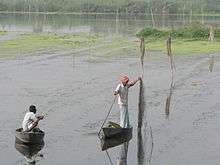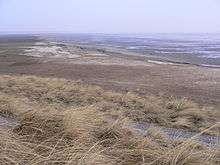Ramsar Convention
| Convention on Wetlands | |
|---|---|
|
Ramsar logo | |
| Signed | 2 February 1971 |
| Location | Ramsar (Iran) |
| Effective | 21 December 1975 |
| Condition | Ratification by 7 states |
| Parties | 169 |
| Depositary | Director General of UNESCO |
| Languages |
English, French and Spanish www |
The Ramsar Convention is an international treaty for the conservation and sustainable use of wetlands.[1] It is also known as the Convention on Wetlands. It is named after the city of Ramsar in Iran, where the Convention was signed in 1971.
Every three years, representatives of the Contracting Parties meet as the Conference of the Contracting Parties (COP), the policy-making organ of the Convention which adopts decisions (Resolutions and Recommendations) to administer the work of the Convention and improve the way in which the Parties are able to implement its objectives.
The most recent COP12 was held in Punta del Este, Uruguay, in 2015. COP13 will take place in Dubai, United Arab Emirates, in 2018.
About the Convention and Wetlands
Wetlands are vital for human survival. They are among the world’s most productive environments; cradles of biological diversity that provide the water and productivity upon which countless species of plants and animals depend for survival.
Wetlands are indispensable for the countless benefits or “ecosystem services” that they provide humanity, ranging from freshwater supply, food and building materials, and biodiversity, to flood control, groundwater recharge, and climate change mitigation.
Yet study after study demonstrates that wetland area and quality continue to decline in most regions of the world; 64% of the world’s wetlands have disappeared in the last century. As a result, the ecosystem services that wetlands provide to people are compromised.
Managing wetlands is a global challenge, and the Convention’s 169 Contracting Parties recognize the value of having one international treaty dedicated to a single ecosystem. By setting international standards for wetland conservation and providing a forum for discussing global wetland issues, the Convention enables Contracting Parties to share information on wetlands and address issues together.
The Convention uses a broad definition of wetlands. It includes all lakes and rivers, underground aquifers, swamps and marshes, wet grasslands, peatlands, oases, estuaries, deltas and tidal flats, mangroves and other coastal areas, coral reefs, and all human-made sites such as fish ponds, rice paddies, reservoirs and salt pans.

The Convention’s mission is “the conservation and wise use of all wetlands through local and national actions and international cooperation, as a contribution towards achieving sustainable development throughout the world”.
Under the “three pillars” of the Convention, the Contracting Parties commit to:
- Work towards the wise use of all their wetlands;
- Designate suitable wetlands for the List of Wetlands of International Importance (the “Ramsar List”) and ensure their effective management;
- Cooperate internationally on transboundary wetlands, shared wetland systems and shared species.
Wise use of Wetlands

At the centre of the Ramsar philosophy is the “wise use” of wetlands. When they accede to the Convention, Contracting Parties commit to work towards the wise use of all the wetlands and water resources in their territory, through national plans, policies and legislation, management actions and public education. The Convention defines wise use of wetlands as “the maintenance of their ecological character, achieved through the implementation of ecosystem approaches, within the context of sustainable development[2]”. Wise use can thus be seen as the conservation and sustainable use of wetlands and all the services they provide, for the benefit of people and nature.
In 1990 the Contracting Parties adopted Guidelines for the implementation of the wise use concept. The Guidelines emphasized the importance of: adopting national wetland policies, either separately or as a component of wider initiatives such as national environmental action plans; developing programmes covering wetland inventory, monitoring, research, training, education and public awareness; developing integrated management plans at wetland sites.
The List of Wetlands of International Importance (the "Ramsar List")
At the time of joining the Convention, each Contracting Party undertakes to designate at least one wetland site for inclusion in the List of Wetlands of International Importance.

The inclusion of a “Ramsar Site” in the List embodies the government’s commitment to take the steps necessary to ensure that its ecological character is maintained. Wetlands included in the List acquire a new national and international status: they are recognized as being of significant value not only for the country or the countries in which they are located, but for humanity as a whole.
The List of Wetlands of International Importance included 2,231 Ramsar Sites in March 2016 covering over 2.1 million square kilometres. The country with the highest number of Sites is the United Kingdom with 170, and the country with the greatest area of listed wetlands is Bolivia, with over 140,000 square kilometres.[3]
The Ramsar Sites Information Service (RSIS) is a searchable database which provides information on each Ramsar Site.
International Cooperation
Transboundary Ramsar Sites

Increasingly, Contracting Parties are designating their new and existing Ramsar Sites as Transboundary Ramsar Sites. These are ecologically coherent, shared wetlands extending across national borders, which are managed collaboratively by the authorities on all sides of the border under a formal agreement. In 2016 there are 18 Transboundary Ramsar Sites.
Ramsar Regional Initiatives
Groups of Contracting Parties with a common geographical focus or goal can also work together as “Regional Initiatives operating within the framework of the Ramsar Convention”. There are two types of regional initiatives: Ramsar Regional Centres for training and capacity building, and networks for regional cooperation. In 2016 there are 15 Ramsar Regional Initiatives covering regions of the Mediterranean, Asia, Africa and South America.
International Organization Partners
The Ramsar Convention works closely with six other organisations known as International Organization Partners (IOPs). These are:
- Birdlife International
- International Union for Conservation of Nature (IUCN)
- International Water Management Institute (IWMI)
- Wetlands International
- WWF International
- Wildfowl & Wetlands Trust (WWT)
These organizations support the work of the Convention by providing expert technical advice, helping implement field studies and providing financial support. The IOPs also participate regularly as observers in all meetings of the Conference of the Parties and as full members of the Scientific and Technical Review Panel.
Other Partners
The Convention collaborates with a network of partners:
- Biodiversity-related conventions including the Convention on Biological Diversity (CBD), the Convention to Combat Desertification (UNCCD), Convention on Migratory Species (CMS), the World Heritage Convention (WHC), and the Convention on International Trade in Endangered Species (CITES);
- Project funding bodies including global environmental funds, multilateral development banks and bilateral donors;
- UN agencies such as UNEP, UNDP, UNESCO and the UN Economic Commission for Europe, and specific programmes such as UNESCO’s Man and the Biosphere (MAB) programme;
- Non-governmental organizations including the Nature Conservancy, Conservation International, the Society of Wetland Scientists, the International Association for Impact Assessment, and many others;
- Since 1998 the Convention has also benefited from a strong partnership with the Danone Group including the Evian brand, and since 2007 from the Biosphere Connections partnership with the Star Alliance airline network.
Bodies established by the Convention
Conference of the Parties (COP)
Conference of the Parties (COP) is the Convention's governing body consisting of all governments that have ratified the treaty. This ultimate authority reviews progress under the Convention, identifies new priorities, and sets work plans for members. The COP can also make amendments to the Convention, create expert advisory bodies, review progress reports by member nations, and collaborate with other international organizations and agreements.
The Standing Committee
The Standing Committee is the intersessional executive body which represents the COP between its triennial meetings, within the framework of the decisions made by the COP. The Contracting Parties that are members of the Standing Committee are elected by each meeting of the COP to serve for the three years until the next one.

The Scientific and Technical Review Panel (STRP)
The Scientific and Technical Review Panel provides scientific and technical guidance to the Conference of the Parties, the Standing Committee, and the Ramsar Secretariat.
The Secretariat
The Secretariat carries out the day-to-day coordination of the Convention’s activities. It is based at the headquarters of the International Union for the Conservation of Nature (IUCN) in Gland, Switzerland.
The implementation of the Ramsar Convention is a continuing partnership between the Contracting Parties, the Standing Committee, and the Convention Secretariat, with the advice of the subsidiary expert body, the Scientific and Technical Review Panel (STRP), and the support of the International Organization Partners (IOPs).
World Wetlands Day

The 2nd of February each year is World Wetlands Day, marking the date of the adoption of the Convention on Wetlands on 2 February 1971. Established to raise awareness about the value of wetlands for humanity and the planet, WWD was celebrated for the first time in 1997 and has grown remarkably since then. In 2015 World Wetlands Day was celebrated in 59 countries.
See also
- List of Ramsar wetlands of international importance
- Ramsar Classification System for Wetland Type
- World Wetlands Day
- Ramsar Wetland Conservation Award
- Environmental agreements
References
- ↑ "The Ramsar Convention and its Mission". Retrieved 11 October 2016.
- ↑ "Ramsar official website".
- ↑ "Ramsar Sites Information Service".
External links
- Ramsar Convention on Wetlands official website
- Ramsar Sites Information Service: official List of all Ramsar Sites website
- Official World Wetlands day website
- The Ramsar Wetland Conservation Award
| Wikimedia Commons has media related to Ramsar Convention. |


